Assessment of Air Quality Perception and Its Effects on Users’ Thermal Comfort in Office Buildings
Abstract
:1. Introduction
2. Materials and Methods
2.1. Study Contextualisation
2.2. Statistical Analyses
3. Results and Discussion
3.1. Data Overview
3.2. Air Quality Satisfaction
3.3. CO2 Concentration
4. Conclusions
Author Contributions
Funding
Institutional Review Board Statement
Informed Consent Statement
Data Availability Statement
Acknowledgments
Conflicts of Interest
References
- Brasche, S.; Bischof, W. Daily time spent indoors in German homes–Baseline data for the assessment of indoor exposure of German occupants. Int. J. Hyg. Environ. Health 2005, 208, 247–253. [Google Scholar] [CrossRef]
- European Commission. Indoor Air Pollution: New EU Research Reveals Higher Risks than Previously Thought. 2003. Available online: https://ec.europa.eu/commission/presscorner/detail/en/IP_03_1278 (accessed on 27 January 2020).
- Klepeis, N.E.; Nelson, W.C.; Ott, W.R.; Robinson, J.P.; Tsang, A.M.; Switzer, P.; Behar, J.V.; Hern, S.C.; Engelmann, W.H. The National Human Activity Pattern Survey (NHAPS): A resource for assessing exposure to environmental pollutants. J. Expo. Anal. Environ. Epid. 2001, 11, 231–252. [Google Scholar] [CrossRef] [PubMed] [Green Version]
- Che, W.W.; Tso, C.Y.; Sun, L.; Ip, D.Y.K.; Lee, H.; Chao, C.Y.H.; Lau, A.K.H. Energy consumption, indoor thermal comfort and air quality in a commercial office with retrofitted heat, ventilation and air conditioning (HVAC) system. Energy Build. 2019, 201, 202–215. [Google Scholar] [CrossRef]
- Khovalyg, D.; Kazanci, O.B.; Halvorsen, H.; Gundlach, I.; Bahnfleth, W.P.; Toftum, J.; Olesen, B.W. Critical review of standards for indoor thermal environment and air quality. Energy Build. 2020, 213, 109819. [Google Scholar] [CrossRef]
- Kim, J.; Hong, T.; Kong, M.; Jeong, K. Building occupants’ psycho-physiological response to indoor climate and CO2 concentration changes in office buildings. Build. Environ. 2020, 169, 106596. [Google Scholar] [CrossRef]
- Candas, V.; Dufour, A. Thermal Comfort: Multisensory Interactions? J. Physiol. Anthropol. 2005, 24, 33–36. [Google Scholar] [CrossRef] [Green Version]
- Bellia, L.; Alfano, F.R.A.; Fragliasso, F.; Palella, B.I.; Riccio, G. On the interaction between lighting and thermal comfort: An integrated approach to IEQ. Energy Build. 2021, 231, 110570. [Google Scholar] [CrossRef]
- Campos, E.C.; Guedes, B.A.M. Relatório Técnico: Impactos da Pandemia de COVID-19 Sobre Sistemas de ar Condicionado e Climatização [Technical Report: Impacts of COVID-19 Pandemic on Air-Conditioning Systems and Climatization]. 2020. Available online: https://www2.ufjf.br/noticias/wp-content/uploads/sites/2/2020/07/relatorio_tecnico__impactos_da_pandemia_de_covid_19__sobre_sistemas_de_ar_condicionado_e_climatizacao.pdf (accessed on 15 July 2020).
- Hoek, G.; Krishnan, R.M.; Beelen, R.; Peters, A.; Ostro, B.; Brunekreef, B.; Kaufman, J.D. Long-term air pollution exposure and cardio-respiratory mortality: A review. Environ. Health 2013, 12, 43. [Google Scholar] [CrossRef] [Green Version]
- Hussin, M.; Ismail, M.R.; Ahmad, M.S. Air-conditioned university laboratories: Comparing CO2 measurement for centralized and split-unit systems. J. King Saud Univ.—Eng. Sci. 2017, 29, 191–201. [Google Scholar] [CrossRef] [Green Version]
- Hamid, A.A.; Johansson, D.; Bagge, H. Ventilation measures for heritage office buildings in temperate climate for improvement of energy performance and IEQ. Energy Build. 2020, 211, 109822. [Google Scholar] [CrossRef]
- Liu, J.; Dai, X.; Li, X.; Jia, S.; Pei, J.; Sun, Y.; Lai, D.; Shen, X.; Sun, H.; Yin, H.; et al. Indoor air quality and occupants’ ventilation habits in China: Seasonal measurement and long-term monitoring. Build. Environ. 2018, 142, 119–129. [Google Scholar] [CrossRef]
- Park, D.Y.; Chang, S. Effects of combined central air conditioning diffusers and window-integrated ventilation system on indoor air quality and thermal comfort in an office. Sustain. Cities Soc. 2020, 61, 102292. [Google Scholar] [CrossRef]
- Sun, Y.; Hou, J.; Cheng, R.; Sheng, Y.; Zhang, X.; Sundell, J. Indoor air quality, ventilation and their associations with sick building syndrome in Chinese homes. Energy Build. 2019, 197, 112–119. [Google Scholar] [CrossRef]
- Toftum, J.; Jorgensen, A.S.; Fanger, P.O. Upper limits of air humidity for preventing warm respiratory discomfort. Energy Build. 1998, 28, 15–23. [Google Scholar] [CrossRef]
- Zhai, Y.; Arens, E.; Elsworth, K.; Zhang, H. Selecting air speeds for cooling at sedentary and non-sedentary office activity levels. Build. Environ. 2017, 122, 247–257. [Google Scholar] [CrossRef]
- Zhai, Y.; Zhang, H.; Zhang, Y.; Pasut, W.; Arens, E.; Meng, Q. Comfort under personally controlled air movement in warm and humid environments. Build. Environ. 2013, 65, 109–117. [Google Scholar] [CrossRef] [Green Version]
- Asif, A.; Zeeshan, M.; Zahanzaib, M. Indoor temperature, relative humidity and CO2 levels assessment in academic buildings with different heating, ventilation and air-conditioning systems. Build. Environ. 2018, 133, 83–90. [Google Scholar] [CrossRef]
- Jamaludin, N.M.; Mahyuddin, N.; Akashah, F.W. Assessment on Indoor Environmental Quality (IEQ) with the application of potted plants in the classroom: Case of University Malaya. J. Des. Built Environ. 2017, 17, 1–15. [Google Scholar] [CrossRef]
- Lee, M.C.; Mui, K.W.; Wong, L.T.; Chan, W.Y.; Lee, E.W.M.; Cheung, C.T. Student learning performance and indoor environmental quality (IEQ) in air-conditioned university teaching rooms. Build. Environ. 2012, 49, 238–244. [Google Scholar] [CrossRef]
- Indraganti, M.; Rao, K.D. Effect of age, gender, economic group and tenure on thermal comfort: A field study in residential buildings in hot and dry climate with seasonal variations. Energy Build. 2010, 42, 273–281. [Google Scholar] [CrossRef]
- Choi, J.; Moon, J. Impacts of human and spatial factors on user satisfaction in office environments. Build. Environ. 2017, 114, 23–35. [Google Scholar] [CrossRef]
- Wagner, A.; Gossauer, E.; Moosmann, C.; Gropp, T.; Leonhart, R. Thermal comfort and workplace occupant satisfaction–Results of field studies in German low energy office buildings. Energy Build. 2007, 39, 758–769. [Google Scholar] [CrossRef]
- Alvares, C.A.; Stape, J.L.; Sentelhas, P.C.; Gonçalves, J.L.M.; Sparovek, G. Köppen’s climate classification map for Brazil. Meteorol. Z. 2013, 22, 711–728. [Google Scholar] [CrossRef]
- Ministry of Agriculture, Livestock, and Supply, Brazilian Institute of Meteorology (INE). Climatological Standards (1981–2010). 2018. Available online: https://portal.inmet.gov.br/normais (accessed on 28 November 2021).
- American Society of Heating. Refrigerating and Air-Conditioning Engineers. ANSI/ASHRAE Standard 55–2013: Thermal Environmental Conditions for Human Occupancy. 2013. Available online: https://www.ashrae.org/technical-resources/bookstore/thermal-environmental-conditions-for-human-occupancy (accessed on 28 November 2021).
- International Organization for Standardization. ISO 16000:1: Indoor Air–General Aspects of Sampling Strategy. 2004. Available online: https://www.iso.org/standard/39844.html (accessed on 28 November 2021).
- International Organization for Standardization. ISO 16000:26: Indoor Air–Sampling Strategy for Carbon Dioxide (CO2). 2012. Available online: https://www.iso.org/standard/52140.html (accessed on 28 November 2021).
- Rupp, R.F.; Kim, J.; Dear, R.; Ghisi, E. Associations of occupant demographics, thermal history and obesity variables with their thermal comfort in air-conditioned and mixed-mode ventilation office buildings. Build. Environ. 2018, 135, 1–9. [Google Scholar] [CrossRef]
- Givoni, B.; Khedari, J.; Wong, N.H.; Feriadi, H.; Noguchi, M. Thermal sensation responses in hot, humid climates: Effects of humidity. Build. Res. Inf. 2006, 34, 496–506. [Google Scholar] [CrossRef]
- Nicol, F.; Humphreys, M.; Roaf, S. Adaptive Thermal Comfort Principles and Practice; Routledge: London, UK, 2012. [Google Scholar]
- Oliveira, C.C.; Rupp, R.F.; Ghisi, E. Influência da umidade do ar no conforto térmico de usuários de edificações de escritórios localizadas no clima subtropical úmido de Florianópolis/SC [Influence of air humidity on users’ thermal comfort in office buildings located in the humid subtropical climate of Florianópolis/SC]. In Proceedings of the Encontro Nacional de Conforto no Ambiente Construído, João Pessoa, Brazil, 18–20 September 2019. [Google Scholar]
- International Organization for Standardization. ISO 7726: Ergonomics of the Thermal Environment–Instruments for Measuring Physical Quantities. 1998. Available online: https://www.iso.org/standard/14562.html (accessed on 28 November 2021).
- Ackerly, K.; Brager, G.; Arens, E. Data Collection Methods for Assessing Adaptive Comfort in Mixed-Mode Buildings and Personal Comfort Systems. UC Berkeley–Indoor Environmental Quality (IEQ). 2012. Available online: https://escholarship.org/uc/item/64p9111k (accessed on 20 January 2021).
- Damiati, S.A.; Zaki, S.A.; Rijal, H.B.; Wonorahardjo, S. Field study on adaptive thermal comfort in office buildings in Malaysia, Indonesia, Singapore, and Japan during hot and humid season. Build. Environ. 2016, 109, 208–223. [Google Scholar] [CrossRef]
- Brazil. Brazilian Health Regulatory Agency (Anvisa), Resolution n. 9. 2003. Available online: http://portal.anvisa.gov.br/documents/10181/2718376/RE_09_2003_.pdf/8ccafc91-1437-4695-8e3a-2a97deca4e10 (accessed on 20 June 2020).
- Fernández-Agüera, J.; Domínguez-Amarillo, S.; Alonso, C.; Martín-Consuegra, F. Thermal comfort and indoor air quality in low-income housing in Spain: The influence of airtightness and occupant behaviour. Energy Build. 2019, 199, 102–114. [Google Scholar] [CrossRef]
- Suzuki, E.H. Avaliação do Conforto Térmico e do Nível de CO2 em Edifícios de Escritório com Climatização Artificial na Cidade de São Paulo [Evaluation of Thermal Comfort and CO2 level in Office Buildings with Artificial Air-Conditioning in the City of São Paulo]. Master’s Dissertation, Polytechnic School of the University of São Paulo, São Paulo, Brazil, 2010. [Google Scholar]
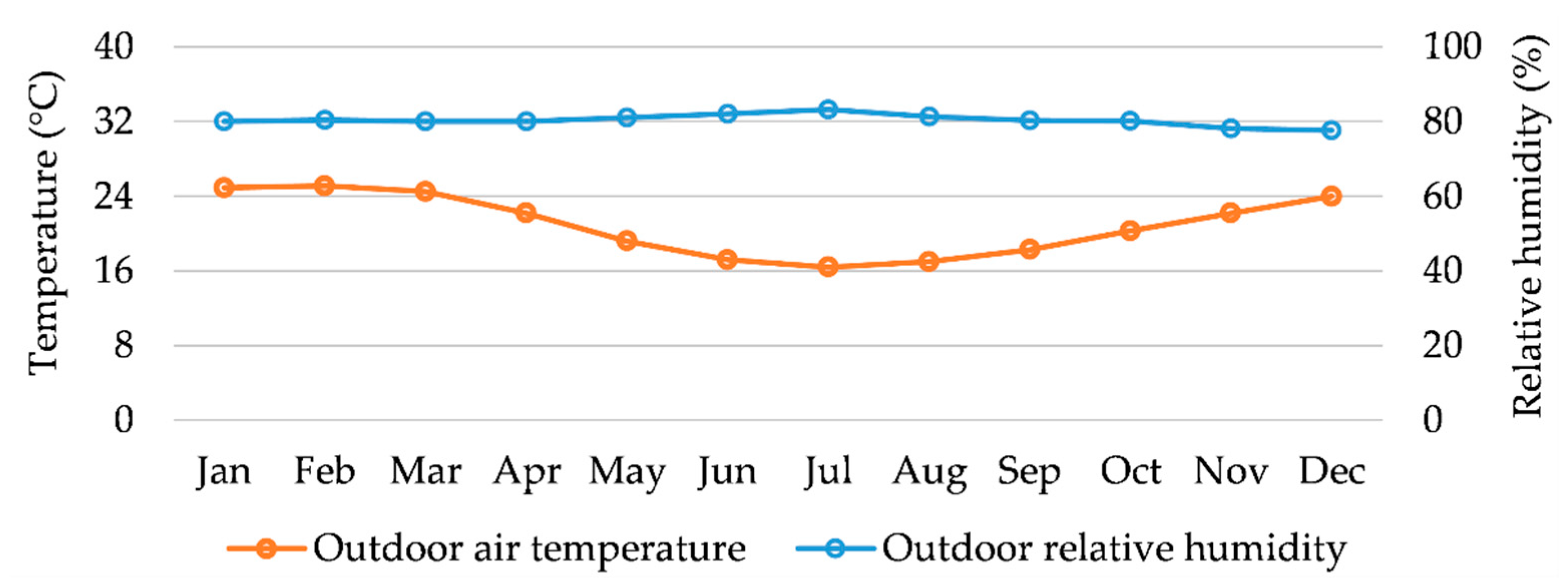
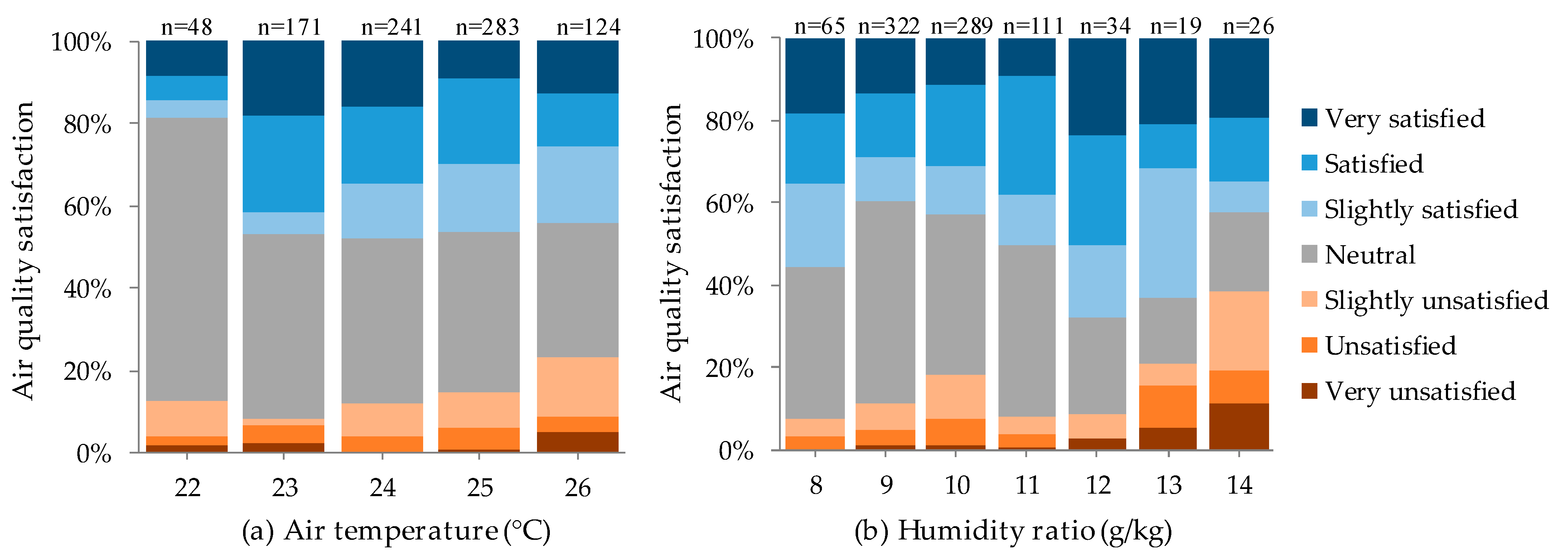
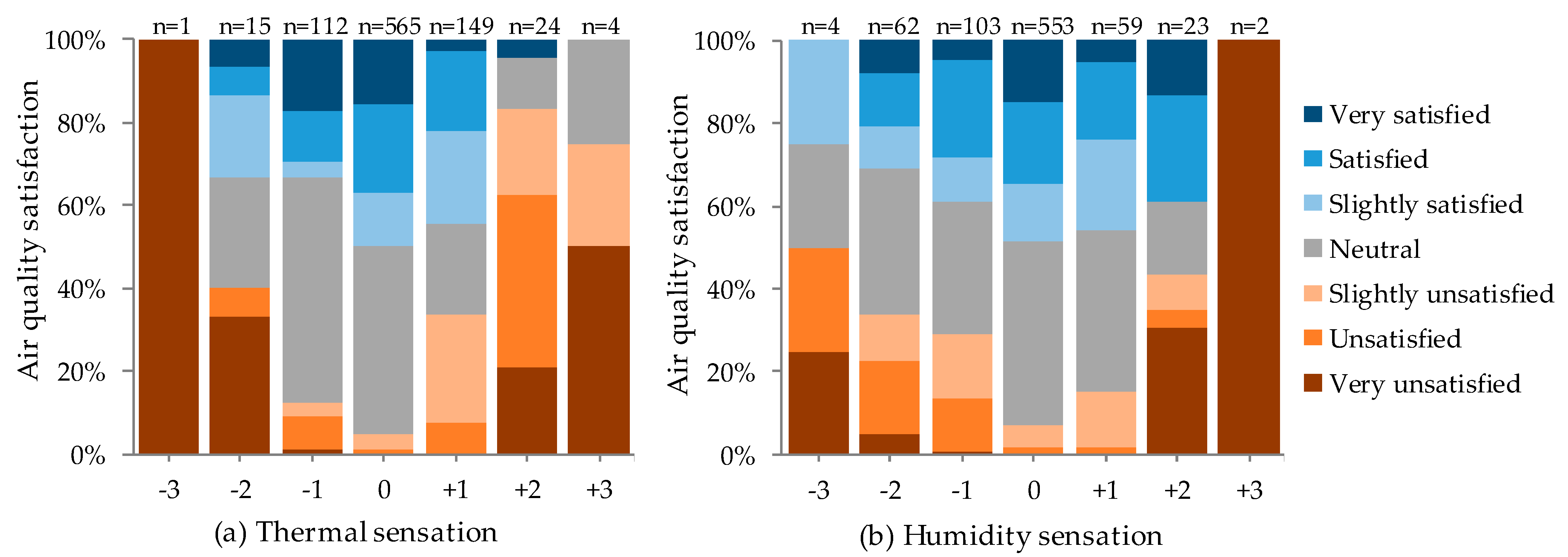

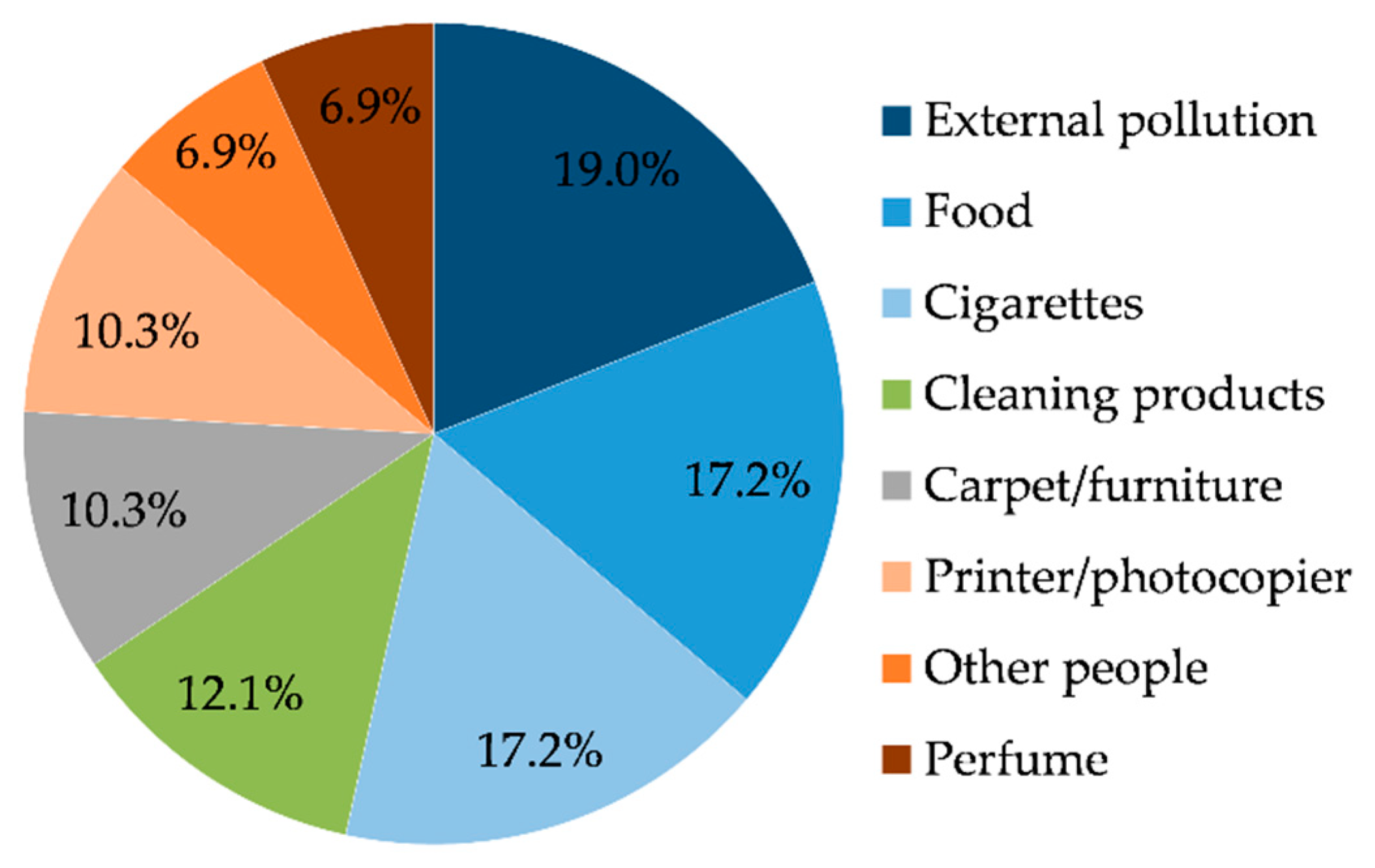
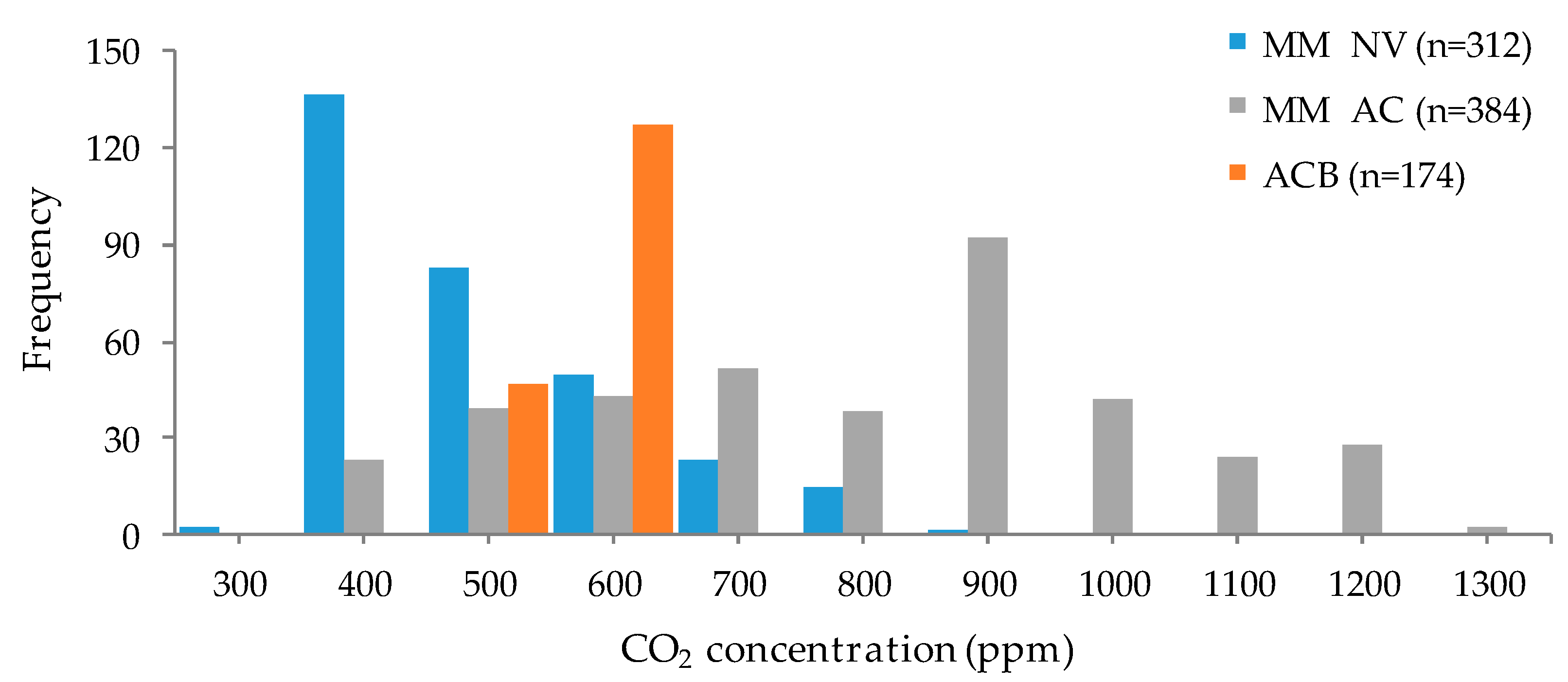
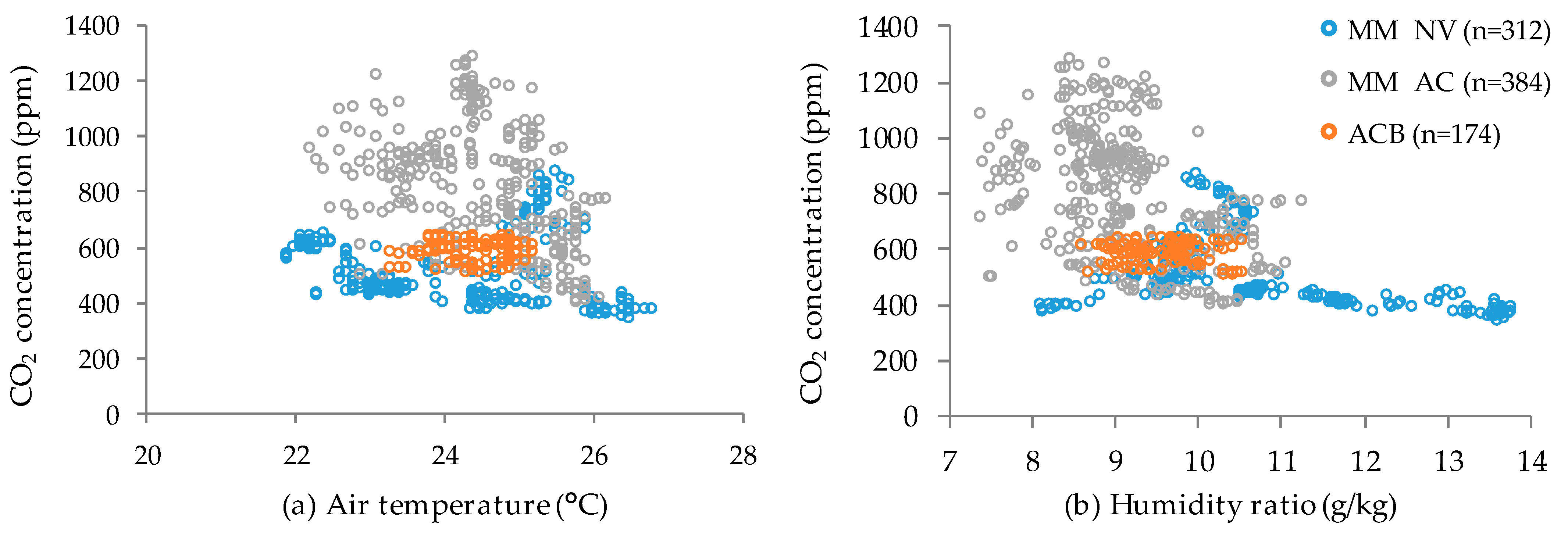
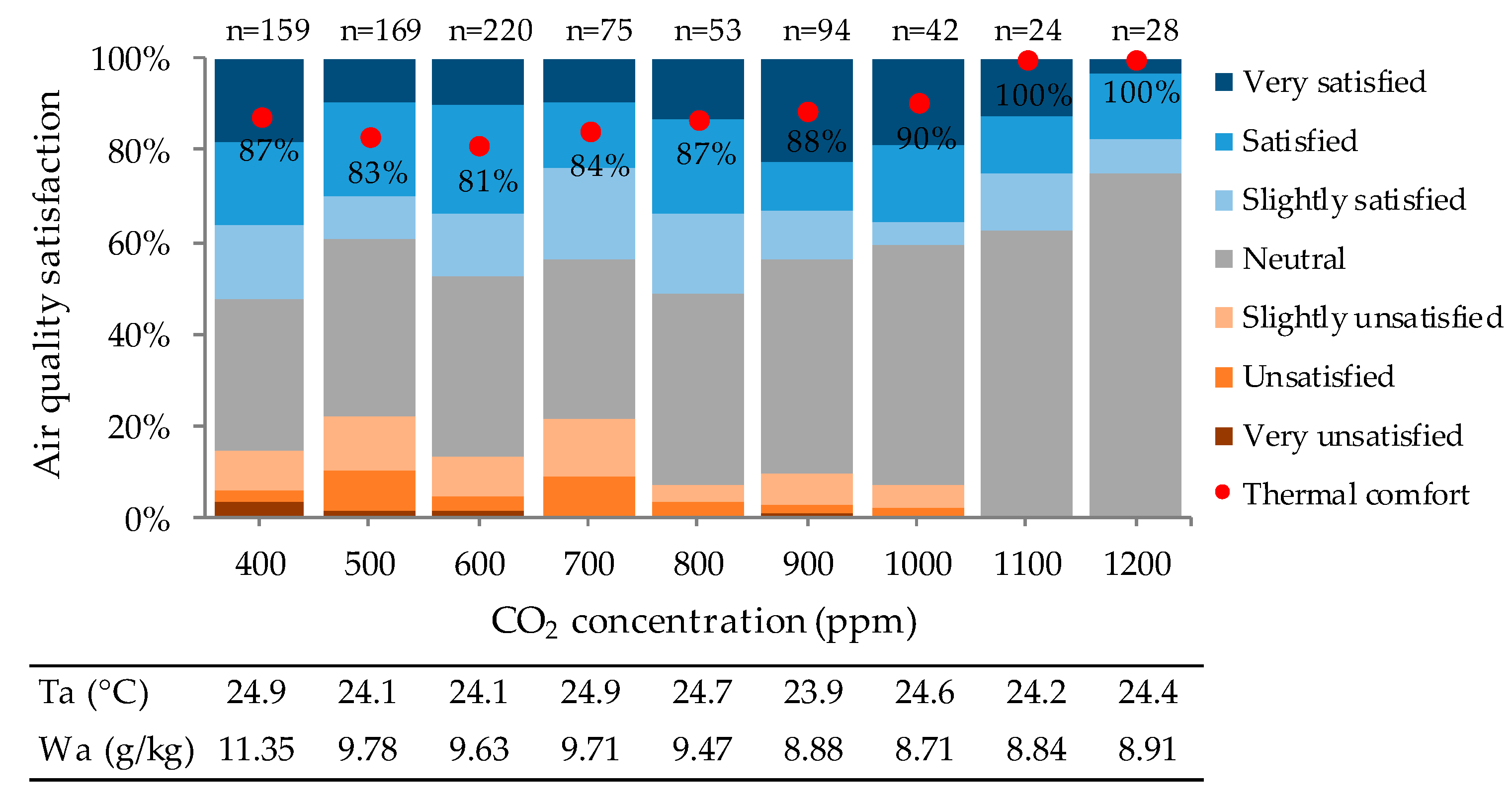
| Parameters | Scales | |
|---|---|---|
| Thermal sensation | +3 | Hot |
| +2 | Warm | |
| +1 | Slightly warm | |
| 0 | Neutral | |
| −1 | Slightly cool | |
| −2 | Cool | |
| −3 | Cold | |
| Thermal acceptability | +1 | Unacceptable |
| 0 | Acceptable | |
| Thermal comfort | +1 | Uncomfortable |
| 0 | Comfortable | |
| Air movement sensation | +2 | Very low air movement |
| +1 | Low air movement | |
| 0 | Enough air movement | |
| −1 | High air movement | |
| −2 | Very high air movement | |
| Air movement acceptability | +1 | Unacceptable |
| 0 | Acceptable | |
| Humidity sensation * | +3 | Very wet |
| +2 | Wet | |
| +1 | Slightly wet | |
| 0 | Neutral | |
| −1 | Slightly dry | |
| −2 | Dry | |
| −3 | Very dry | |
| Humidity acceptability * | +1 | Unacceptable |
| 0 | Acceptable | |
| Air quality satisfaction | +3 | Very satisfied |
| +2 | Satisfied | |
| +1 | Slightly satisfied | |
| 0 | Neutral | |
| −1 | Slightly unsatisfied | |
| −2 | Unsatisfied | |
| −3 | Very unsatisfied | |
| Variables | MMB1 | MMB2 | ACB | |||
|---|---|---|---|---|---|---|
| (mean ± S.D.) | NV (n = 80) | AC (n = 55) | NV (n = 232) | AC (n = 329) | AC (n = 174) | |
| Environmental | Ta (°C) | 23.4 ± 1.5 | 23.8 ± 0.9 | 24.4 ± 1.2 | 24.6 ± 0.9 | 24.4 ± 0.5 |
| Tout (°C) | 18.7 ± 2.1 | 24.5 ± 2.4 | 20.2 ± 2.8 | 25.2 ± 2.4 | 23.2 ± 0.5 | |
| Tg (°C) | 23.4 ± 1.4 | 24.5 ± 1.1 | 24.5 ± 1.1 | 24.9 ± 0.9 | 24.7 ± 0.4 | |
| Va (m/s) | 0.1 ± 0.0 | 0.1 ± 0.0 | 0.1 ± 0.1 | 0.1 ± 0.0 | 0.1 ± 0.2 | |
| RH (%) | 67 ± 3 | 60 ± 2 | 69 ± 7 | 57 ± 4 | 61 ± 3 | |
| RHout (%) | 81 ± 9 | 76 ± 0 | 85 ± 4 | 77 ± 3 | 71 ± 7 | |
| Wa (g/kg) | 10.01 ± 0.34 | 9.12 ± 0.36 | 10.96 ± 1.52 | 9.15 ± 0.84 | 9.66 ± 0.51 | |
| CO2 (ppm) | 661 ± 90 | 1046 ± 143 | 449 ± 67 | 774 ± 207 | 581 ± 40 | |
| Occupant-related | Age (years) | 41 ± 8 | 46 ± 10 | 37 ± 12 | 36 ± 11 | 40 ± 9 |
| Weight (kg) | 64 ± 8 | 72 ± 13 | 71 ± 15 | 70 ± 14 | 81 ± 16 | |
| Height (m) | 1.65 ± 0.05 | 1.69 ± 0.08 | 1.68 ± 0.10 | 1.67 ± 0.09 | 1.75 ± 0.07 | |
| BMI (kg/m2) | 23.5 ± 2.6 | 24.9 ± 3.1 | 25.0 ± 4.2 | 24.7 ± 3.9 | 26.4 ± 4.0 | |
| Clothing insulation (clo) | 0.88 ± 0.31 | 0.54 ± 0.06 | 0.69 ± 0.15 | 0.60 ± 0.11 | 0.62 ± 0.09 | |
| Metabolic rate (met) | 1.2 ± 0.2 | 1.2 ± 0.1 | 1.2 ± 0.1 | 1.2 ± 0.1 | 1.2 ± 0.1 | |
| Air Quality Satisfaction | Thermal Comfort (%) | Thermal Discomfort (%) | |||||
|---|---|---|---|---|---|---|---|
| MM NV | MM AC | ACB | MM NV | MM AC | ACB | ||
| n = 263 | n = 339 | n = 143 | n = 49 | n = 45 | n = 31 | ||
| +3 | Very satisfied | 11.8 | 15.9 | 19.6 | 0.0 | 2.2 | 0.0 |
| +2 | Satisfied | 21.3 | 15.0 | 34.3 | 2.0 | 4.4 | 19.4 |
| +1 | Slightly satisfied | 14.8 | 10.6 | 17.5 | 0.0 | 15.6 | 16.1 |
| 0 | Neutral | 45.2 | 52.2 | 19.6 | 30.6 | 24.4 | 25.8 |
| −1 | Slightly unsatisfied | 4.9 | 5.9 | 4.9 | 30.6 | 17.8 | 19.4 |
| −2 | Unsatisfied | 1.9 | 0.3 | 4.2 | 18.4 | 31.1 | 9.7 |
| −3 | Very unsatisfied | 0.0 | 0.0 | 0.0 | 18.4 | 4.4 | 9.7 |
Publisher’s Note: MDPI stays neutral with regard to jurisdictional claims in published maps and institutional affiliations. |
© 2021 by the authors. Licensee MDPI, Basel, Switzerland. This article is an open access article distributed under the terms and conditions of the Creative Commons Attribution (CC BY) license (https://creativecommons.org/licenses/by/4.0/).
Share and Cite
Oliveira, C.C.d.; Rupp, R.F.; Ghisi, E. Assessment of Air Quality Perception and Its Effects on Users’ Thermal Comfort in Office Buildings. Sci 2021, 3, 47. https://doi.org/10.3390/sci3040047
Oliveira CCd, Rupp RF, Ghisi E. Assessment of Air Quality Perception and Its Effects on Users’ Thermal Comfort in Office Buildings. Sci. 2021; 3(4):47. https://doi.org/10.3390/sci3040047
Chicago/Turabian StyleOliveira, Candi Citadini de, Ricardo Forgiarini Rupp, and Enedir Ghisi. 2021. "Assessment of Air Quality Perception and Its Effects on Users’ Thermal Comfort in Office Buildings" Sci 3, no. 4: 47. https://doi.org/10.3390/sci3040047
APA StyleOliveira, C. C. d., Rupp, R. F., & Ghisi, E. (2021). Assessment of Air Quality Perception and Its Effects on Users’ Thermal Comfort in Office Buildings. Sci, 3(4), 47. https://doi.org/10.3390/sci3040047








